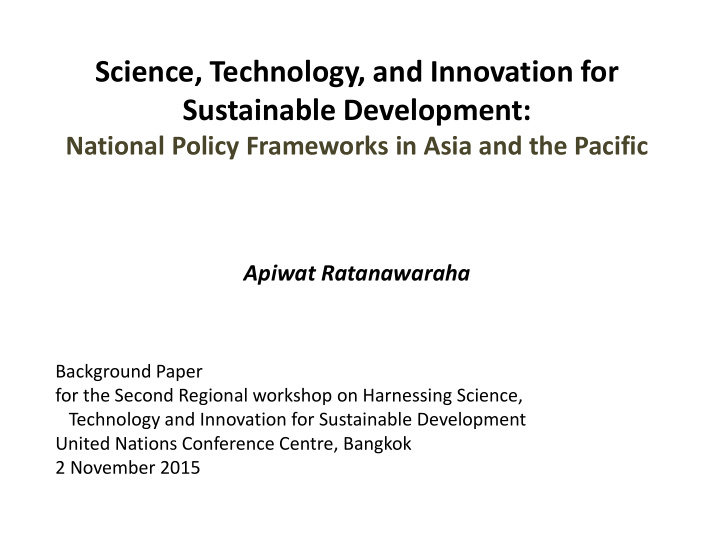



Science, Technology, and Innovation for Sustainable Development: National Policy Frameworks in Asia and the Pacific Apiwat Ratanawaraha Background Paper for the Second Regional workshop on Harnessing Science, Technology and Innovation for Sustainable Development United Nations Conference Centre, Bangkok 2 November 2015
Main questions • What is the status of STI4SD policies across the Asia- Pacific region? • What are the main policy gaps identified? • How can those gaps be closed? • Is there scope to regionalize selected policies? What kinds of STI policies support and drive systemic transitions towards sustainability?
Conceptual framework • Starting point: ESCAP memos from the 1 st workshop • “A Conceptual Framework for Science, Technology and Innovation Driven Sustainable Development and the Role of ESCAP” • “Open Working Group proposal for Sustainable Development Goals.” • Why innovation systems – identify system failures • strengths and weaknesses at the system level, which may be less noticeable at the product, process, or organizational levels. • mainly focus on sectoral innovation system and technological innovation system at the national level
Sustainable development in SDGs • Very broadly defined • Not only production, but includes consumption, livelihoods, and social justice issues • SD is not limited to production of sustainable technologies by firms, and the adoption and consumption by firms and households • SD is a process of systemic transitions of the whole socio-economic-technical systems towards sustainability
Innovation systems for STI4SD Requires rethinking about innovation systems • Objectives – Not just economic competitiveness social well-being, environmental improvement, and social justice • Boundary – Have to be beyond a sector, a group of technologies, and even a geographical boundary • Systemic change – Incremental and minor improvement to existing ways of production, consumption, distribution is not enough – sustainable development requires systemic transformation – socio-technical transitions
Innovation systems for STI4SD • Actors and networks – beyond triple helix: + civil society & NGOs + the media – Not just top-down approach to policy making “democratization of innovation” • Institutions – rules, norms, and incentives: beyond profitability • Knowledge – may not be limited to commoditized knowledge – traditional knowledge, local wisdom
Innovation systems for STI4SD Need to integrate three systems approaches to STI policies • Sectoral innovation systems • Technological innovation systems • Socio-technical transitions
• Importance of overall sustainability policy and legal frameworks • Policies that aim to enhance industrial competitiveness through sustainable production • National focus, limited efforts in developing regional and local innovation systems • Mixed roles of multinational firms in innovation systems • Relatively “closed” innovation systems in STI policy framework: limited consideration of trade
Current STI4SD policy frameworks in ESCAP countries Review of STI and sustainability-related national policy frameworks in select ESCAP countries Findings • Wide-ranging degrees of integration of STI policies and sustainability-oriented policies – Generally, align with the state of development • Mostly linear model of STI: public-sector driven, supply push, and sector-based innovation systems
Findings • Institutional framework is taking shape for competitiveness-oriented innovation systems but not for sustainability-oriented systems – Korea, Japan, Singapore integrating the two • Sectoral approach to STI policy framework for sustainable development – Energy, water, transport, etc
Findings • Lack of spatial dimensions in innovation systems literature and policy making • Focus on competitiveness of firms, little integration with inclusive development policies – Inclusive innovation, social innovation • Gaps in R&D for sustainable technologies
Policy options • Increase the horizontality of sustainability-oriented STI policies and integration with development planning • Multi-stakeholder processes and institutions in creating sustainability-oriented STI policy framework • Capacity-building policy and mobilization of resources for sustainability-oriented STI • Administrative decentralization and STI – Area-based STI policy and planning
• Expanding the boundary of knowledge in the innovation system – Open Science, Citizen science, Indigenous knowledge • Build foresight capability – Risks and uncertainty • Explore market-based solutions – Impact investing • Increase regional cooperation in STI4SD – Standardization, monitoring and evaluation systems – Regional knowledge infrastructure
Recommend
More recommend